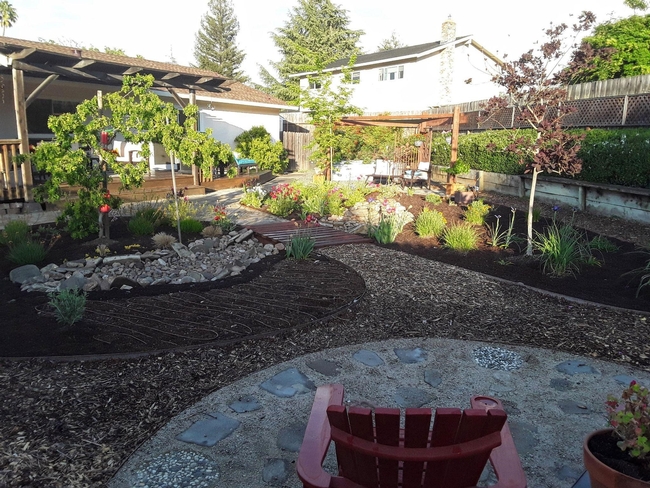by Melody Kendall
Designing a new or updating an old landscape can seem like an overwhelming chore to some. Breaking the whole experience into steps or looking at different considerations first will help to center or focus all your efforts. Last week we covered the first steps. This week we'll finish:
-Cost & other considerations
-Draw out existing landscape
-Add important notations
-Additional Considerations
-Locate research based gardening info to facilitate the proposed project

Draw out existing landscape: Start bringing all this information into focus. Roughly draw out your existing landscape. Start with scratch paper, a pencil and a big eraser. If your project perimeter is large, you will need a helper to hold the measure tape. Homeowners might not have a long measure tape, so the process will have to be done in steps. There are programs available on line that will allow you to not only view your entire property from above in real time and have measuring tools available for your use. It is much easier to use one of these programs to measure the larger distances. Print out this photo and write in the measurements as they are taken. Whichever method you use, record all measurements on your rough drawing. Using this information and graph paper, do a final property drawing. Keep the original photo print for your reference.
Add important notations: When planning a landscape, project measurements are not the only important information that will be needed for a successful outcome. Elevations, structures and hardscapes, to name a few, create certain conditions in your garden that will need to be taken into consideration when making plant and design decisions.
-Points of the compass: a north facing landscape area has very different conditions than a south facing area.
-Prevailing winds: the local wind conditions are a big factor in plant selection. In our south valley the winds are much more constant than those upper valley locations. Some plants just don't like the wind.
-Lines of sight: Say you have a wonderful view of the mountains you want to preserve and enhance, not so much the neighbor's chicken coop. When choosing plantings for those areas, think of the mature height of plants.
-Locate the existing irrigation lines and hose bibs: Plus, water access is important information to have when choosing plants for any area.
-Sun/shade coverage: The points of the compass, structures, large trees and the sun's changing trajectory in winter and summer create areas that at one time of the year might be in shade but at other times of the year in the sun. Determining that sun/shade coverage is rather easy using this formula: Go out at night during a full moon and observe where the moonlight falls, this is where the sun will fall six months. Example: Jan moonlight=June sunlight.
-Mark all of this information on your final drawing and make multiple copies for your use during the project.
Additional Considerations: There are some further items that need to be considered before beginning your project:
-Check with local nurseries for plant inventory availability and plan for any fulfillment delays
-Landscape vs hardscape: know the difference. With some exceptions altering/installing hardscapes is best done in the spring or early summer to take advantage of the softer soil from the winter rains. Plant installation, on the other hand, is usually best done in late fall or early winter. This will allow the plant to take advantage of any winter rains.
-Consider climate change and how it will affect your final design plan.
-Record the locations of existing/updated irrigation in the landscape on one of the copies of your property drawing. Save this in your records to refer to in the years to come.
-Record all plant ID information and save this information in a file to be referred to as needed.
-Check out the various design related free apps and software options online and try them out.
-There are many research based websites available for your discovery and exploration
As a final step: Take one copy of your final drawing and in the area slated for change, rough out the planned landscape project. You now have a very nice folder filled with information about landscape design in general and your project specifically. Become familiar with this information and make any changes to your original design plan as information suggests. Empowered with this knowledge you can start your project and have a successful experience.
Napa Master Gardeners are available to answer garden questions by email: mastergardeners@countyofnapa.org. or phone at 707-253-4143. Volunteers will get back to you after they research answers to your questions.
Visit our website: napamg.ucanr.edu to find answers to all of your horticultural questions.
Photo credits: Mel Kendall
Information links:
UC Master Gardeners of Napa County-Step-by-step Garden Design
https://napamg.ucanr.edu/GardenDesign/